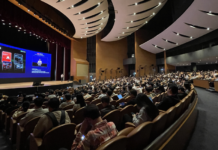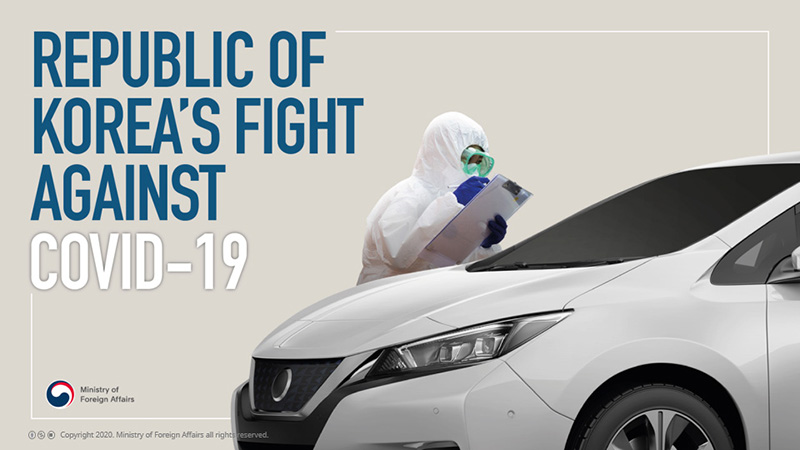
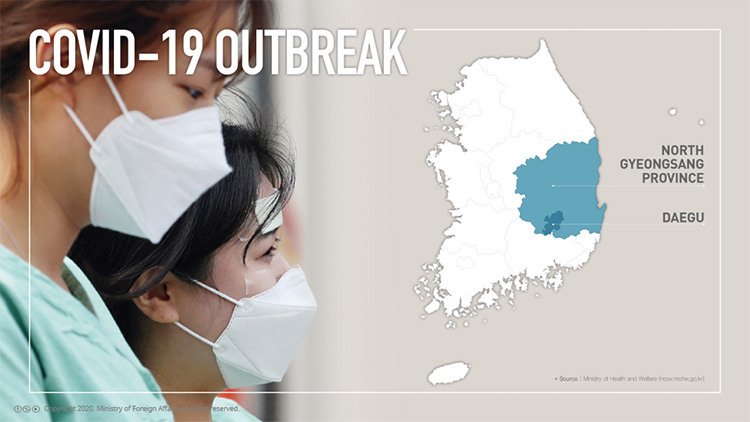
The COVID-19 situation in Korea is characterized by confirmed cases originating from a specific regional cluster, namely Daegu and North Gyeongsang Province.
As of March 9, there were 7,382 confirmed cases, with 6,678 cases in Daegu and North Gyeongsang and 704 in the rest of the country.*
The number of confirmed cases outside of Daegu and North Gyeongsang remains relatively low at about 10% of total cases.
*Source: Ministry of Health and Welfare (ncov.mohw.go.kr)
- – 01 –
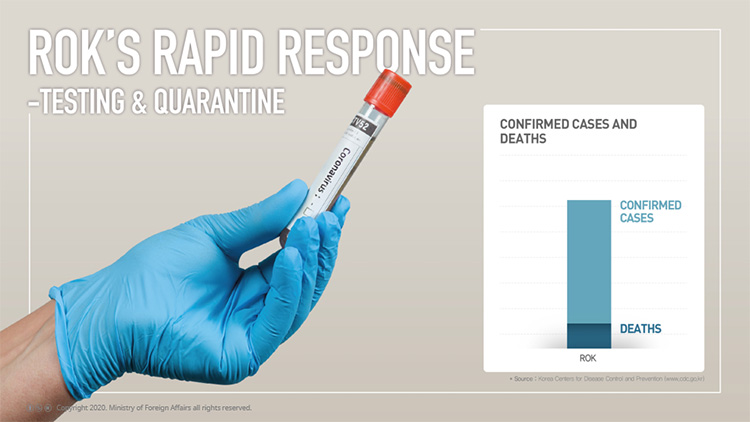
The recent increase in the number of confirmed cases demonstrates the ROK Government’s rapid response to the outbreak, from swift deployment of testing and quarantining capabilities to reporting of accurate and transparent data.
The ROK Government quickly tested, approved and ramped up production of domestically developed diagnostic kits, and is able to test up to 18,000 people per day. The cumulative number of diagnostic tests completed as of March 9 was 196,618.* This means that one out of around every 260 people in Korea have been tested, an overwhelmingly high ratio compared to other affected countries. The ROK is leading the world in the detection of cases and prevention of COVID-19’s further spread. The testing of suspected patients and treatment for anyone confirmed are free, including for foreigners who may need care. Those under self-quarantine at home are also paid living expenses to help offset lost wages. The ROK has also focused on expeditious recovery of those infected with COVID-19 through its advanced medical care. Most COVID-19 related deaths in Korea have been among the elderly or those with preexisting medical conditions. The mortality rate of COVID-19 in Korea as of March 9 was approximately 0.69%,* which is very low compared to the rest of the world, thanks to the exceptional national health care system that is both robust and accessible.
Complete transparency of data coupled with aggressively testing for asymptomatic persons who have come in contact with confirmed patients have identified even the mildest cases, unlike other countries. This has been a double-edged sword, as it has shown an alarming number of confirmed cases in the ROK in a short amount of time, rising to the highest in the world outside of China. The ROK believes timely and accurate data is crucial to combating further global spread and is committed to transparent sharing of its data on COVID-19 with the international community. Korean health officials are closely coordinating and communicating with the WHO, international health experts and other affected countries, as well as informing the public of every development and government action with full transparency.
*Source: Ministry of Health and Welfare (ncov.mohw.go.kr)
- – 02 –
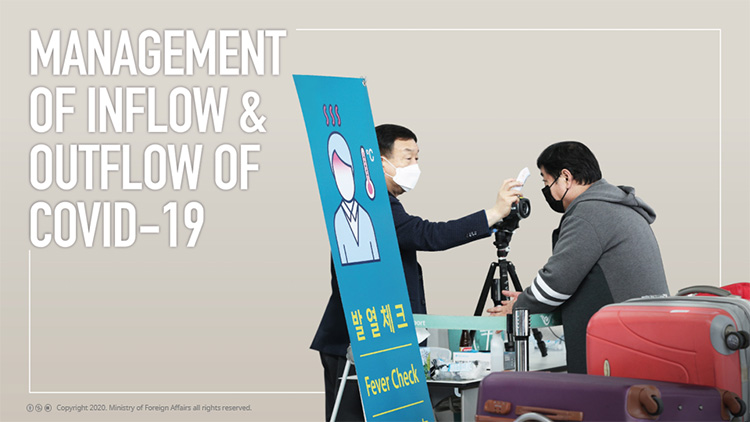
The ROK Government has implemented robust and effective measures in its fight against COVID-19, while minimizing restrictions placed on movement of people and goods. The ROK has not introduced any entry ban on inbound travelers, except those traveling from only a single and the most severely affected area in China. Instead, the ROK implemented its Special Entry Procedure aimed at enhancing health monitoring of travelers coming from certain areas and countries with higher risks, which allowed minimizing the risk of the disease’s spread without an outright entry ban. Travelers returning from affected countries are required to install the Self-Diagnosis App on their smartphones and submit their health status every day for 14 days. If they show early symptoms of infection for more than two consecutive days, the Korea Centers for Disease Control and Prevention (KCDC) and local authorities will take follow up measures.
At the same time, Korea prohibits individuals identified as COVID-19 contacts* from exiting Korea during their 14 day self-quarantine regardless of whether they are symptomatic of COVID-19. The ROK is also making Incheon International Airport into a COVID-19 free zone and have conducted mandatory multi-step fever checks on all outbound passengers.
* Persons who have been within a 2-meter distance from an infected patient, starting one day before the patient showed symptoms, etc.
- – 03 –
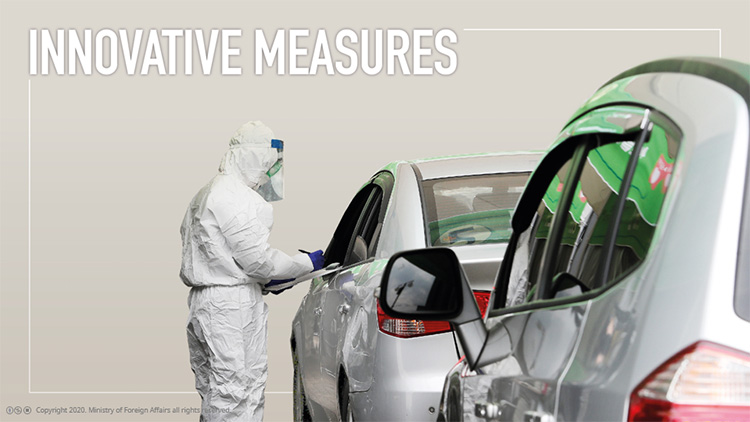
The ROK has applied several innovative measures to combat COVID-19.
To cut time needed for diagnostic screening and limit the exposure of frontline medical workers as well as those who are waiting to be tested, Korea pioneered Drive-through Testing Stations. There are approximately 50 such stations operating around the country, which allow drivers to register and provide samples in under 10 minutes without needing to get out of their vehicles. Many countries have used Korea’s model to deploy their own stations.
City and district governments have partnered with mobile telecommunication companies to send emergency alerts to anyone in the vicinity of confirmed hotspots, ensuring that the public is informed as quickly as possible. Mobile apps were developed to allow users to avoid known hotspots, providing detailed information about the exact location and time of visit by confirmed COVID-19 patients.
The ROK has also developed diagnostic kits that provide fast and accurate results, which has garnered attention from many countries interested in deploying the kits.
- – 04 –
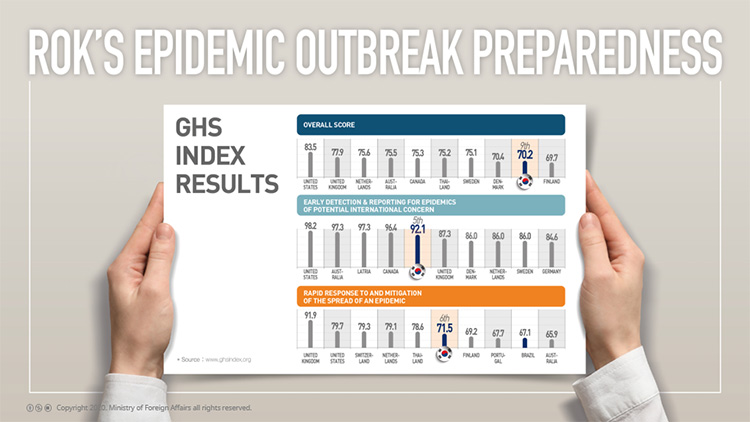
After experiencing SARS and MERS, the ROK has invested and regularly maintained its capabilities to handle any future epidemics.
In the latest 2019 Global Health Security (GHS) Index,* which is a comprehensive assessment and benchmark of health security and related capabilities across 195 countries, the ROK ranked ninth overall.
* The GHS Index is a project of the Nuclear Threat Initiative and the Johns Hopkins Center for Health Security, developed with The Economist and under guidance of a panel of 21 international experts from 13 countries. It is funded by the Open Philanthropy Project, Bill & Melinda Gates Foundation and the Robertson Foundation.
Specifically, in two of the six categories* related to detection, reporting, and response and mitigation of epidemics, the ROK ranked fifth in the world for “early detection and reporting for epidemics of potential international concern” and sixth for “rapid response to and mitigation of the spread of an epidemic.”
*Six categories of GHS Index (ROK’s rank in parenthesis)
- Prevention of emergence or release of pathogens (19th)
- Early detection and reporting for epidemics of potential international concern (5th)
- Rapid response to and mitigation of the spread of an epidemic (6th)
- Sufficient & robust health system to treat the sick and protect health workers (13th)
- Commitments to improving national capacity, financing and adherence to norms (23rd)
- Overall risk environment and country vulnerability to biological threats (27th)
- – 05 –
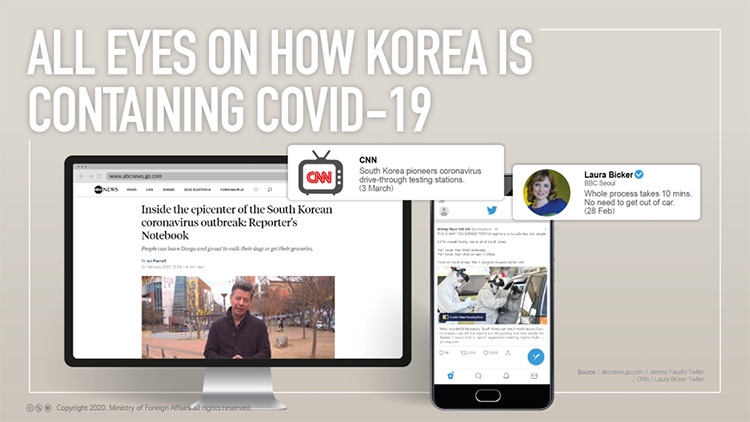
Many experts and media have covered Korea’s response to COVID-19’s spread, particularly its innovative and thorough testing.
- CNN (March 3): “South Korea pioneers coronavirus drive-through testing stations”
- BBC Seoul correspondent’s Laura Bicker’s Twitter (Feb. 28): “whole process takes 10 mins. No need to get out of car”
- Nikkei of Japan (Feb. 29): “Korea’s drive-thru coronavirus tests minimum 10 minutes introduction to expand”
- ABC News of U.S. (Feb. 24): “Daegu is the epicenter of the country’s growing novel coronavirus outbreak. It is also, perhaps, a model for how other cities and towns in the free world might try to deal with the virus”
- South China Morning Post (March 5): “South Korea’s aggressive testing gives clues to true fatality rate”
- – 06 –
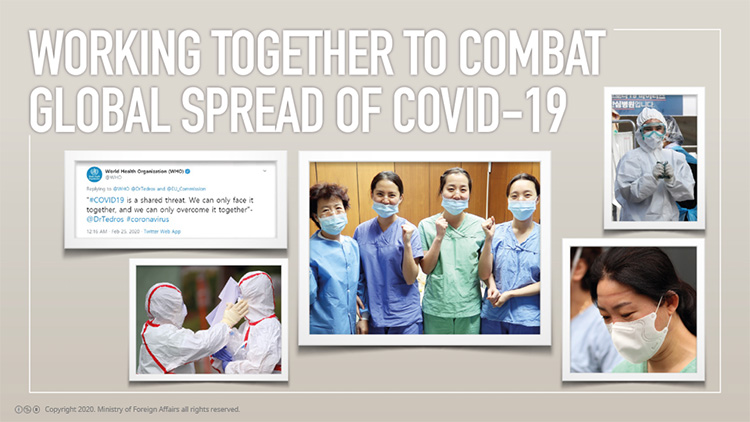
In dealing with the COVID-19 spread, the extensive and integrated infrastructure of Korea’s public health and medical facilities, as well as dedicated medical workers and citizens who voluntarily comply with the precautionary measures such as maintaining “social distancing,” have been vital.
As the director-general of the World Health Organization (WHO), Tedros Adhanom Ghebreyesus, said, “COVID-19 is a shared threat. We can only face it together and we can only overcome it together.”
Our experience will produce many lessons learned, which we hope will contribute to the international community’s understanding of COVID-19 and assist in your own fight against the global spread of COVID-19.
- – 07 –



